Items
Tag is exactly
George Floyd
-
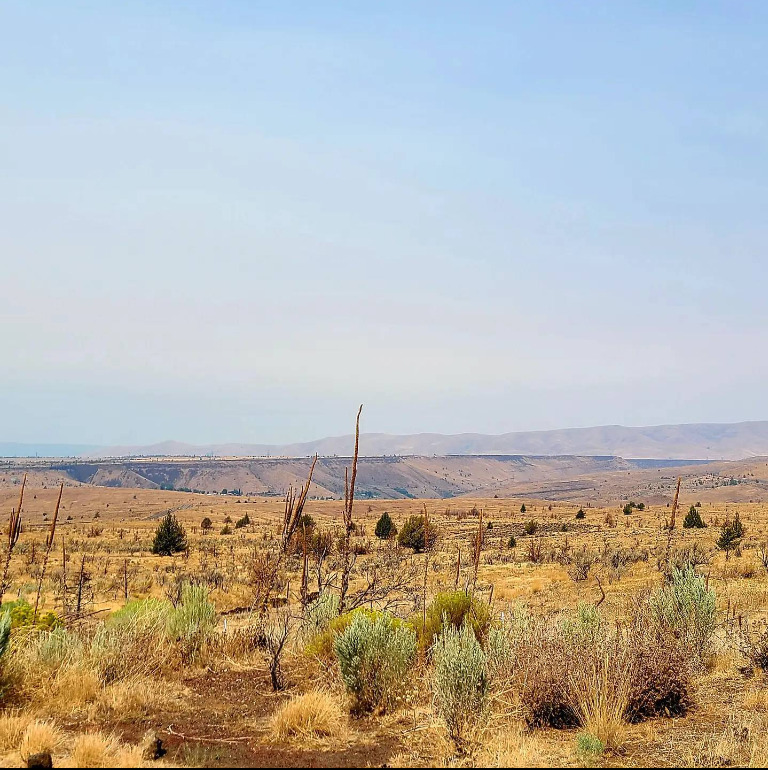 2021-08-15
2021-08-15Pandemics, Wildfires, and Climate Change
The Covid 19 Pandemic is and was a transformative event representing history in the making. The state of Oregon and particularly Portland witnessed a trifecta of converging crises beginning with the lockdown on St. Patrick’s Day in 2020. That summer was one of the hottest in recorded history and saw the city and state divided in smoke-filled chaos. The literal last words of “I can’t breathe” uttered by George Floyd were being chanted in the streets downtown as wildfires raged in all corners of the state, set against the backdrop of a global pandemic. Everything felt surreal and the tension in the city was like a powder keg. By the following summer some advancements had been made, the first round of vaccinations administered, but the same underlying issues were present in Portland. Houselessness, fractured political ideologies, and Far-Right and Far-Left members clashing in an invisible maelstrom on the Willamette River. My husband and I had adhered to the very stringent guidelines and protocol set by both the city and state to the letter. For a bit of context, my husband worked on the front line as a department manager at a grocery store and wore a mask for eleven hours at a time often six days a week for a year and a half, while I volunteered at the Red Cross and held down the home front. In August of 2021, we finally decided that we needed to get out of town, so we grabbed the dog and set a course for the Crooked River in Central Oregon. It was a two-week period of sheer peace and glory bookended by fear and anger at the negligence of fellow humans. We camped on the river and practiced mindfulness and being present every day, breathing deeply the fresh air ushered in by a strong breeze from the East. The “going there” and “going home” portions were marred by anti-mask protestors with weapons arguing about state’s rights, as death toll numbers were rising. The fires had already burned over a million acres with no signs of slowing down, and the reality of Portland’s social justice issues did not disappear just because we did. The experience left us feeling gratitude for the opportunity to explore, our good health, and open minds, it was our 18th wedding anniversary, in which porcelain is traditionally given as a gift. Ironic, given the fact that not only is porcelain extraordinarily beautiful but also incredibly delicate, a perfect representation of the state of things during the summer of 2021. -
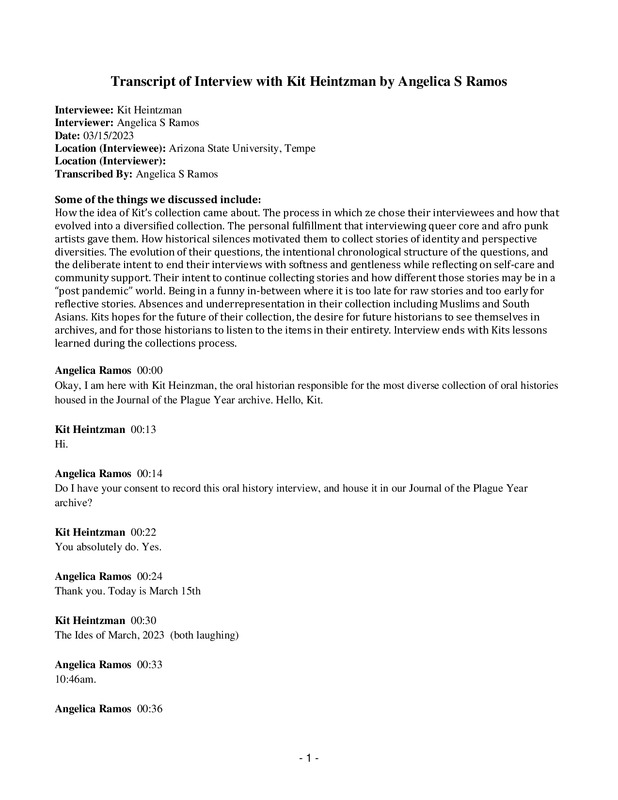 2023-03-15
2023-03-15Kit Heintzman Oral History, 2023/03/15
Kit Heintzman is a recovering academic currently residing in Lenapehoking, who was trained in the medical humanities with a special interest in queer theory, animals, and the history of nationalism. Kit has developed a singular collection of oral histories of the pandemic for A Journal of the Plague Year, collected from a range of individuals with widely diverse experiences. That collection addresses significant silences surrounding the pandemic broadly and within JOTPY more narrowly. In this item Kit is interviewed by Angelica and Erin, both with Arizona State University, about Kits collection process. -
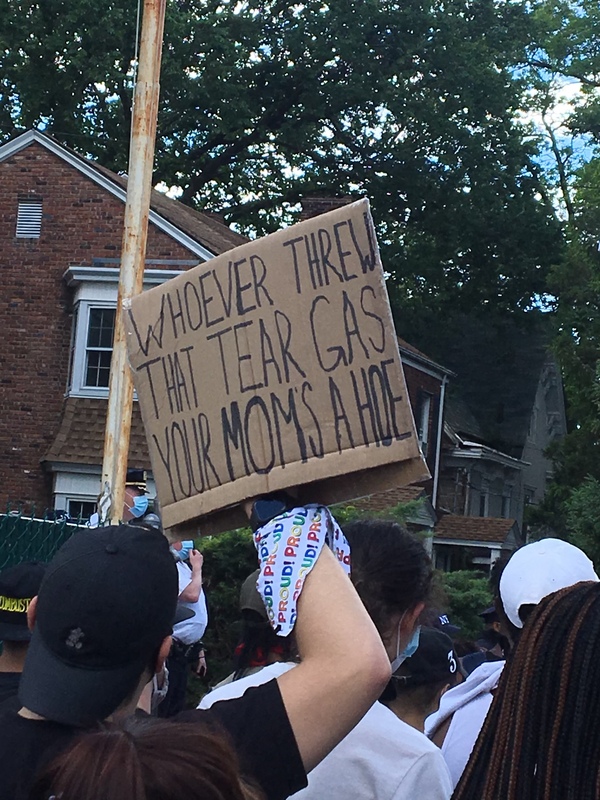 2020-06-09
2020-06-09George Floyd protest
“This is from a protest on June 9th, 2020 I went to, which was in protest of the police and George Floyd’s death. The sign spoke to me and it’s the only picture I have from that day. But I feel like I was part of history that day. It was the first thing I went to with my friends or people since the lockdown started. Before that, I was alone with my family and my thoughts. And so it marked the beginning of a new world of change that we embarked upon.” -
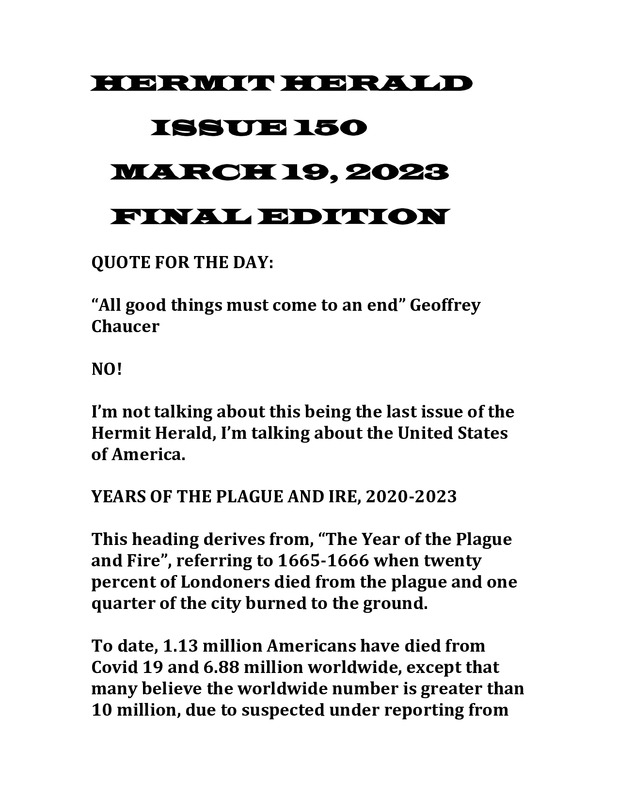 2023-03-19
2023-03-19HERMIT HERALD, ISSUE 150
Final issue, a three year review -
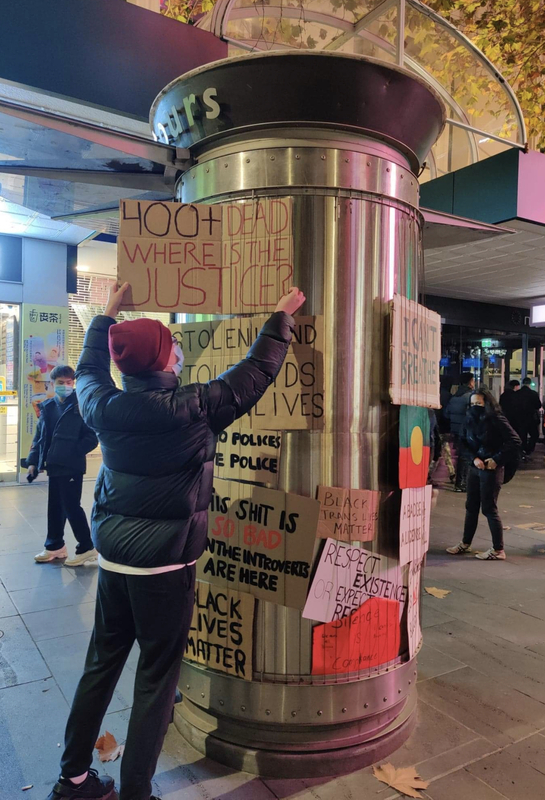 2020-06-06
2020-06-06History within History
HIST30060: This photo was taken at the Melbourne Black Lives Matter protest in June of 2020, it was one amongst the wave of protests taking place across the world sparked by protests in the United States following George Floyd's death at the hands of the police. It was the second protest I had attended and the sheer number of people attending to show solidarity with people of colour in the US and shed light on police issues at home was an inspiring sight despite the harrowing reality of it all. Figures such as the Prime Minister at the time cited health risks as reason to not demonstrate, but this potential of COVID spreading however was consistently weaponised by conservative pundits (despite their consistent calls for lax restrictions). to discredit the movement. -
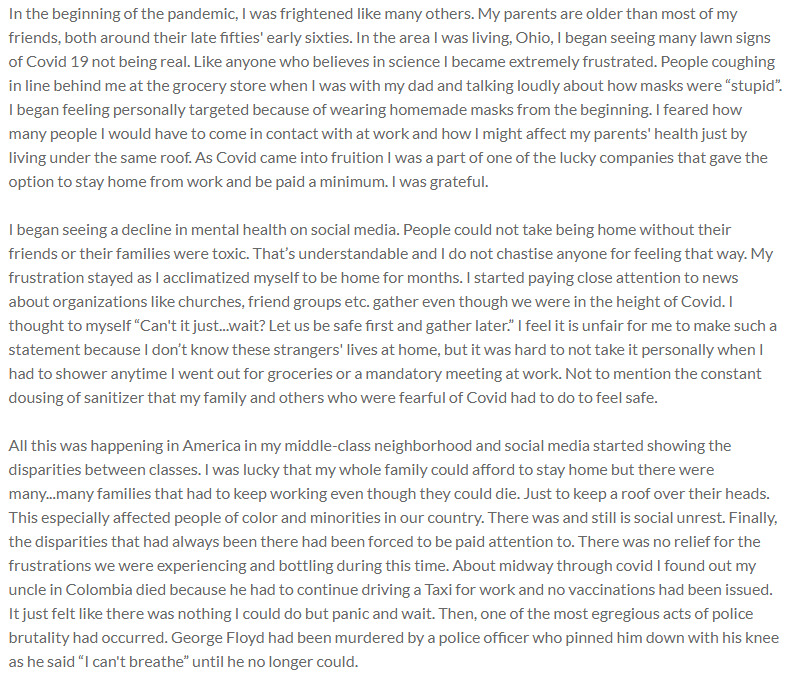 2020-06-01
2020-06-01A privilaged white latina women.
In the beginning of the pandemic, I was frightened like many others. My parents are older than most of my friends, both around their late fifties' early sixties. In the area I was living, Ohio, I began seeing many lawn signs of Covid 19 not being real. Like anyone who believes in science I became extremely frustrated. People coughing in line behind me at the grocery store when I was with my dad and talking loudly about how masks were “stupid”. I began feeling personally targeted because of wearing homemade masks from the beginning. I feared how many people I would have to come in contact with at work and how I might affect my parents' health just by living under the same roof. As Covid came into fruition I was a part of one of the lucky companies that gave the option to stay home from work and be paid a minimum. I was grateful. I began seeing a decline in mental health on social media. People could not take being home without their friends or their families were toxic. That’s understandable and I do not chastise anyone for feeling that way. My frustration stayed as I acclimatized myself to be home for months. I started paying close attention to news about organizations like churches, friend groups etc. gather even though we were in the height of Covid. I thought to myself “Can't it just...wait? Let us be safe first and gather later.” I feel it is unfair for me to make such a statement because I don’t know these strangers' lives at home, but it was hard to not take it personally when I had to shower anytime I went out for groceries or a mandatory meeting at work. Not to mention the constant dousing of sanitizer that my family and others who were fearful of Covid had to do to feel safe. All this was happening in America in my middle-class neighborhood and social media started showing the disparities between classes. I was lucky that my whole family could afford to stay home but there were many...many families that had to keep working even though they could die. Just to keep a roof over their heads. This especially affected people of color and minorities in our country. There was and still is social unrest. Finally, the disparities that had always been there had been forced to be paid attention to. There was no relief for the frustrations we were experiencing and bottling during this time. About midway through covid I found out my uncle in Colombia died because he had to continue driving a Taxi for work and no vaccinations had been issued. It just felt like there was nothing I could do but panic and wait. Then, one of the most egregious acts of police brutality had occurred. George Floyd had been murdered by a police officer who pinned him down with his knee as he said “I can't breathe” until he no longer could. America turned upside down. We saw videos of buildings being destroyed, fires, mass protests, shootings, the worst you could imagen. As a collective we had reached our boiling point and the last straw was this murder. My family was against my brother and I protesting because Covid still being at its height. I have protested at the Womens March in D.C and several pro-choice marches in Ohio but the Black Lives Matter movement was something I needed to educate myself on and stand up for. It was a calling for someone in my position of privilege to show up in numbers for people of color that deserve rights just as the rest of us. I often reflect on how my life could have been so different. My father is Colombian, and my mother is Polish. I look white and have always been raised in a middle-class neighborhood. I have not had to face the same injustices as my father, my family and minority groups in America just based off the color of my skin. Police brutality has always been in existence but when we were all home during Covid with modern day technology and video evidence, we felt that video to the core. We felt the pure rage and frustrations as a society of how we were not being cared for in the way we thought we would have been during this pandemic. I have never witnessed in my lifetime such united support for one another. Such a strong fight against people in power who are coming after the people we call friends, workers, lovers, and family no matter the color of their skin. In such destruction, pain and chaos I had never felt such beauty in our society. I will never forget the feeling of unity around me I had felt as hundreds of people laid down on the hard pavement during the Black lives Matter protest yelling “I cant breathe.” Finally, we could help the unheard be heard and take a deep breath together. -
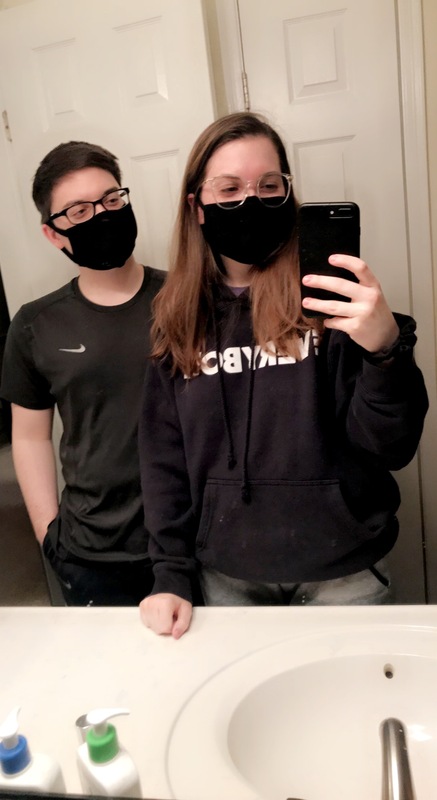 2022-04-29
2022-04-29An ~Interesting~ Time to Say the Least
After living through it for the past two years, there is SO much to say about the COVID-19 pandemic, and I don’t even know where to begin. I guess the main takeaway is that it really forced everyone’s true colors to show. At the beginning in March of 2020, everyone was so uncertain of what was to come, and that alone made it so scary, that most people had no choice but to make light of the situation. I remember not only the grocery store shelves being empty because of everyone over-stocking their pantries and shortages in general, but also the hobby sections of Walmart and Target being empty, which was truly a really beautiful thing to witness. People were taking the time in quarantine to learn more about themselves whether that meant learning new skills or trying out new hobbies and spending time with their families doing puzzles and playing games as well. For me personally, I taught myself how to sew, which is depicted in the attached photo, as I needed to make face masks for my boyfriend and me (out of an old t-shirt) so we could safely go to the grocery store, before masks were widely available. I also learned how to bake really delicious treats, got back into reading, and even painted a few pictures here and there. Aside from these positives, it also brought out a lot of negatives as well including built up anxiety and anger that came out in the form of a new equal rights movement: Black Lives Matter after George Floyd's murder. It was scary at the time because protests and riots got very violent, but any movement for equal rights is a good movement, so it was a positive in the long run. I would say COVID-19 also played a role in the insurrection at the capitol on January 6th of 2021, and more division between political parties regarding vaccines and mandates. One could go on for hours listing all the positive and negative aspects that came about from the pandemic, but it's most important to recognize how resilient we as humans are. I'm proud of how far we've come. -
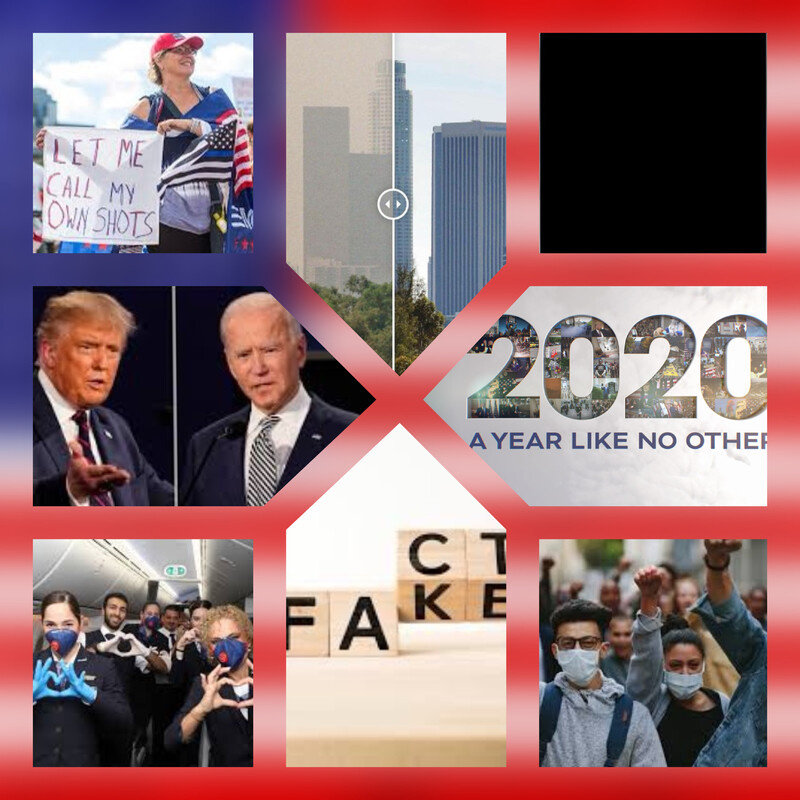 2020-04-06
2020-04-062020 is One for the Books
This collage represents the main events going on in our lives during the Covid-19 pandemic. Like one of my pictures says "2020 A Year Like No Other." I wanted to represent the election of Trump vs. Biden because it will more than likely go down as one of the largest and craziest elections in history. It divided the country like no other and is still an ongoing battle of Republicans vs. Democrats. I wanted to show the black square and the protests for George Floyd along with The Black Lives Matter movement. I added the air pollution of Los Angeles before the pandemic vs during. With everyone staying inside and not driving around, air quality improved tremendously. We gave the Earth a minute to breathe and heal. A quick photo to shoutout the flight attendants who have had to deal with some craziness on board for the last couple years. It has not been easy, and everyone needed a vacation after 2020. The media has been a huge factor and enemy for this pandemic. I wanted to show an illustration towards facts and fake news. A huge debate on that especially with my final photo of the protests on the vaccine mandates. The world is divided more than ever and hopefully one day we can reunite we can reunite and look back on this pandemic and remember to love each other and this planet. There were many lives lost to Covid, to suicide, and addiction. Rest in peace to everyone who didn't make it and my prayers with the families who lost someone. -
2020-09-01
Seattle's 2020 summer, school, and kids
At the end of 2020, I was completing my student teaching online for my BA in Secondary Education. I was placed in a school in Seattle. Student teaching during this time is something that was incredibly difficult. Looking at faces through blurry webcams, and seeing the black tiles in zoom from students who wouldn't or couldn't turn on cameras. I will never know what a lot of the students looked like, or what their voices sounded like, but getting to read their work, and see their messages in emails and chats is something that I will always remember and will always hold a place in my heart. The 12-14-year-olds I was teaching had just been the last 3 1/2 months watching the BLM protests and marches in their city take place. A few students told us that they lived just streets away from the main events. Some students had been active in the BLM marches and protests that had taken place during the summer before, some stayed at home and watched on social media live streams and the news, some had parents who were heavily involved. They watched their friends, their family, their community, and strangers get tear-gassed, hit with "blast balls", and be subject to other physical violence. The levels at which they understood the what and why varied. Some had such an amazing level of nuance that some adults I knew couldn't comprehend. Others had an extremely base understanding of why people were protesting and marching. But all understood that it was a monumental event and would be something remembered in history. These children were scared, concerned, confused for a variety of reasons. Yet, overwhelmingly there was a sense of urgency for justice from these kids. My lead teacher and I knew that we had to pivot lessons in order to keep them engaged and meet their needs. Focusing on how the concepts they needed to learn could be applied to material that would interest them, and using homeroom activities to try to calm nerves, create a sense of community and answer questions about everything from Covid, to the protests, to the current election. They wanted to write and read about what was important to them, what they saw around them, and they wanted to read about different perspectives and lives from their own. We honored that. For the final writing assignment of the semester, we gave them some guidelines and standards that needed to be met within their writing, but gave them some freedom on how they wanted to meet those standards. I won't get into the specifics of the assignment, but I will say it worked well and was adapted to best serve students at all levels, and those with IEP/504 plans. We were met with everything from songs and poetry, letters to the mayor and the governor, essays about our anchor text, to reports about youth activists that they researched. I don't think the impact of the events of summer 2020 in Seattle on children is thought about. The events that a child experiences and is around affects them for the rest of their lives. Most don't have the skills yet to emotionally process fully what they see. Their thinking didn't stop when the marches and protests did, they wanted to learn and talk about it in order to process. The compounding factors of the summer and prior to that Seattle was essentially ground zero for Covid in the U.S. left most kids spinning. School became a safe place for a lot of these kids, and I hope that it has continued to be one. -
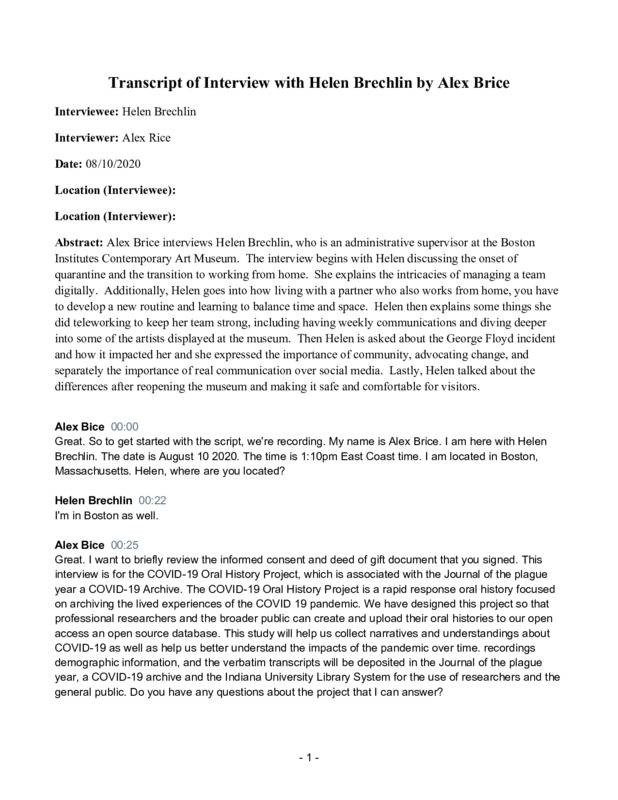 08/10/2020
08/10/2020Helen Brechlin, Oral History, 2020/08/10
Alex Brice interviews Helen Brechlin, who is an administrative supervisor at the Boston Institutes Contemporary Art Museum. The interview begins with Helen discussing the onset of quarantine and the transition to working from home. She explains the intricacies of managing a team digitally. Additionally, Helen goes into how living with a partner who also works from home, you have to develop a new routine and learning to balance time and space. Helen then explains some things she did teleworking to keep her team strong, including having weekly communications and diving deeper into some of the artists displayed at the museum. Then Helen is asked about the George Floyd incident and how it impacted her and she expressed the importance of community, advocating change, and separately the importance of real communication over social media. Lastly, Helen talked about the differences after reopening the museum and making it safe and comfortable for visitors. -
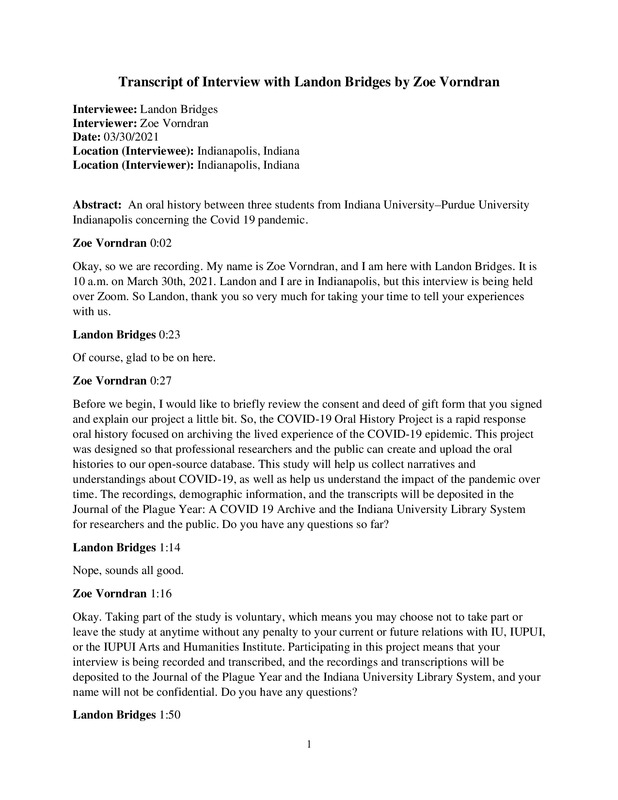 03/30/2021
03/30/2021Landon Bridges Oral History, 2021/03/30
An oral history between three students from Indiana University–Purdue University Indianapolis concerning the Covid 19 pandemic -
 11/27/2020
11/27/2020Cristiano Favazza Oral History, 2020/11/27
C19OH -
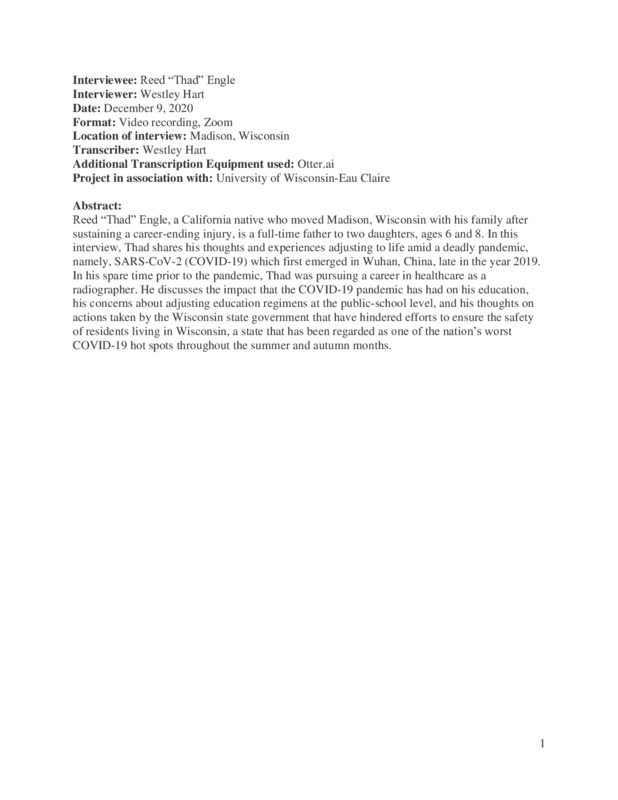 12/09/2020
12/09/2020Reed Engle Oral History, 2020/12/09
C19OH -
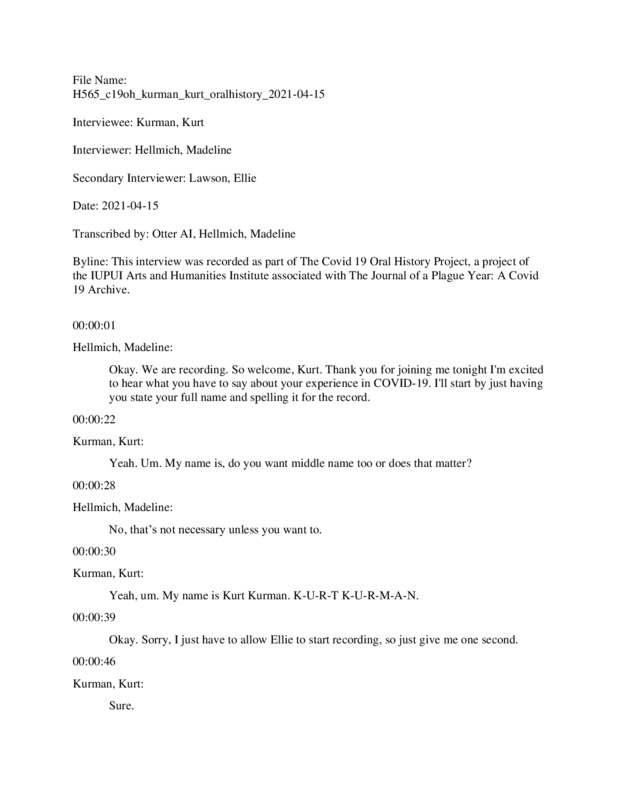 04/15/2021
04/15/2021Kurt Kurman Oral History, 2021/04/15
-
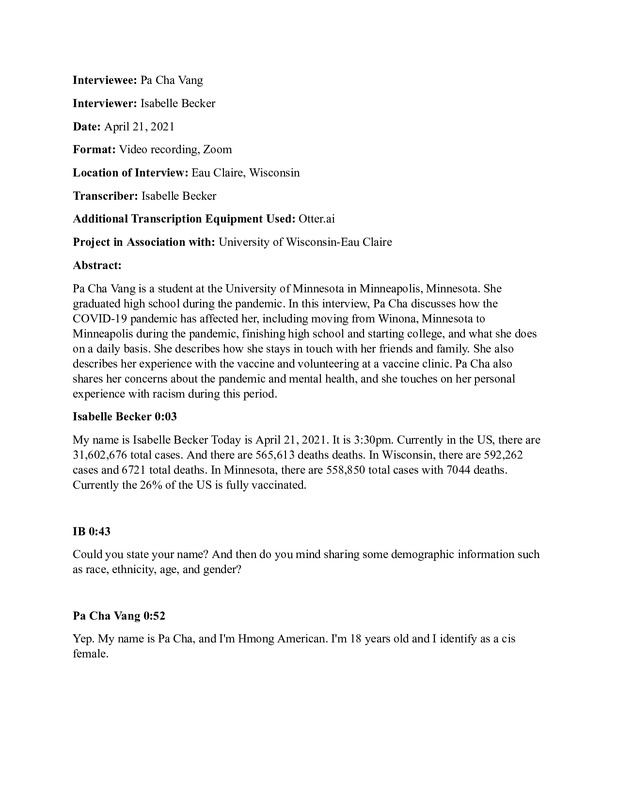 04/21/2021
04/21/2021Pa Cha Vang Oral History, 2021/04/21
Pa Cha Vang is a student at the University of Minnesota in Minneapolis, Minnesota. She graduated high school during the pandemic. In this interview, Pa Cha discusses how the COVID-19 pandemic has affected her, including moving from Winona, Minnesota to Minneapolis during the pandemic, finishing high school and starting college, and what she does on a daily basis. She describes how she stays in touch with her friends and family. She also describes her experience with the vaccine and volunteering at a vaccine clinic. Pa Cha also shares her concerns about the pandemic and mental health, and she touches on her personal experience with racism during this period. -
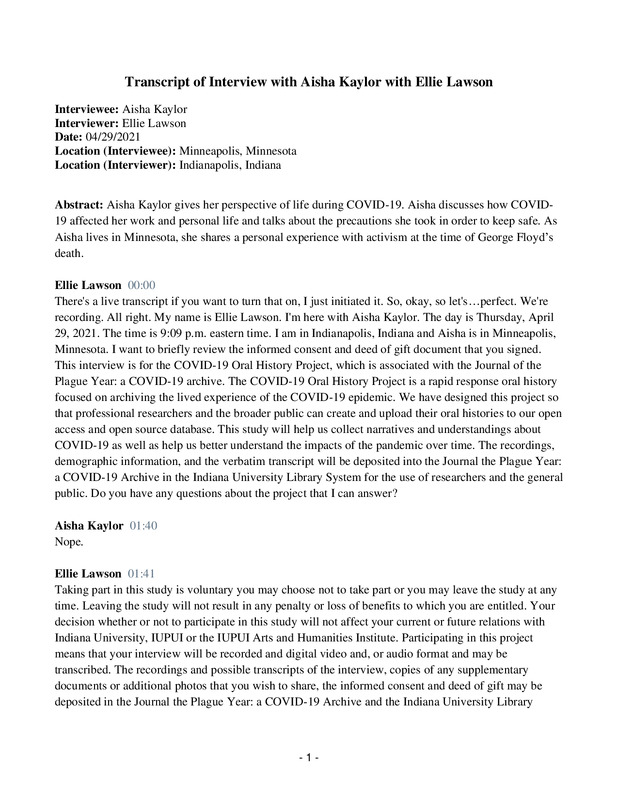 04/29/2021
04/29/2021Aisha Kaylor Oral History, 2021/04/29
-
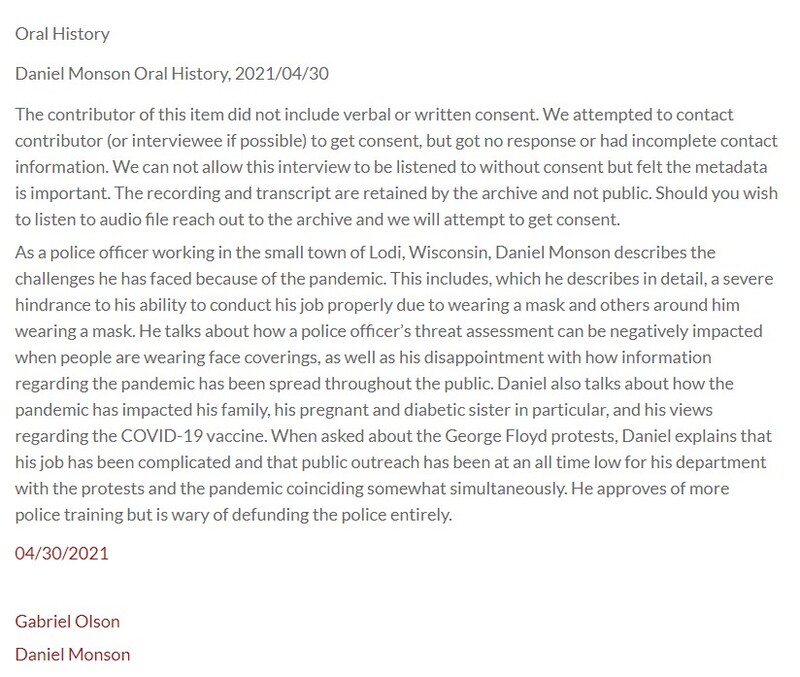 04/30/2021
04/30/2021Daniel Monson Oral History, 2021/04/30
The contributor of this item did not include verbal or written consent. We attempted to contact contributor (or interviewee if possible) to get consent, but got no response or had incomplete contact information. We can not allow this interview to be listened to without consent but felt the metadata is important. The recording and transcript are retained by the archive and not public. Should you wish to listen to audio file reach out to the archive and we will attempt to get consent. -
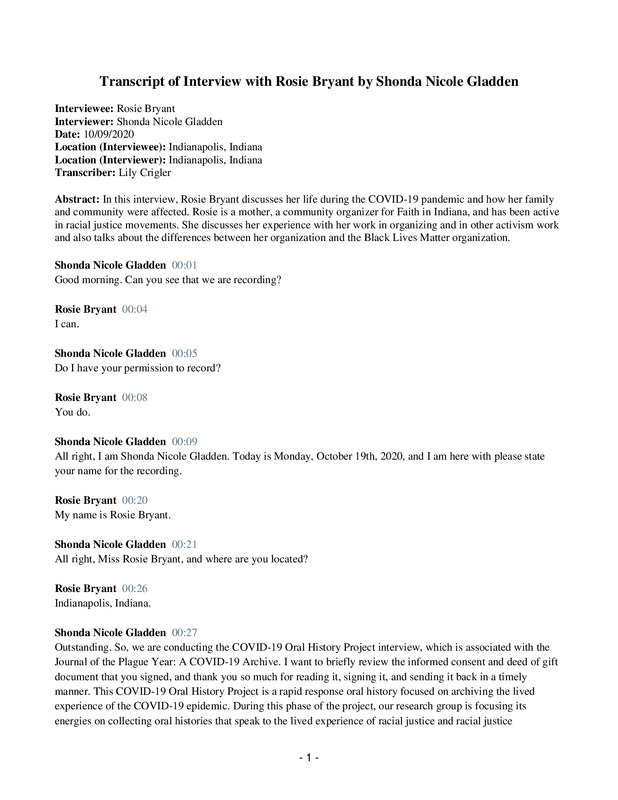 10/19/2020
10/19/2020Rosie Bryant Oral History, 2020/10/19
-
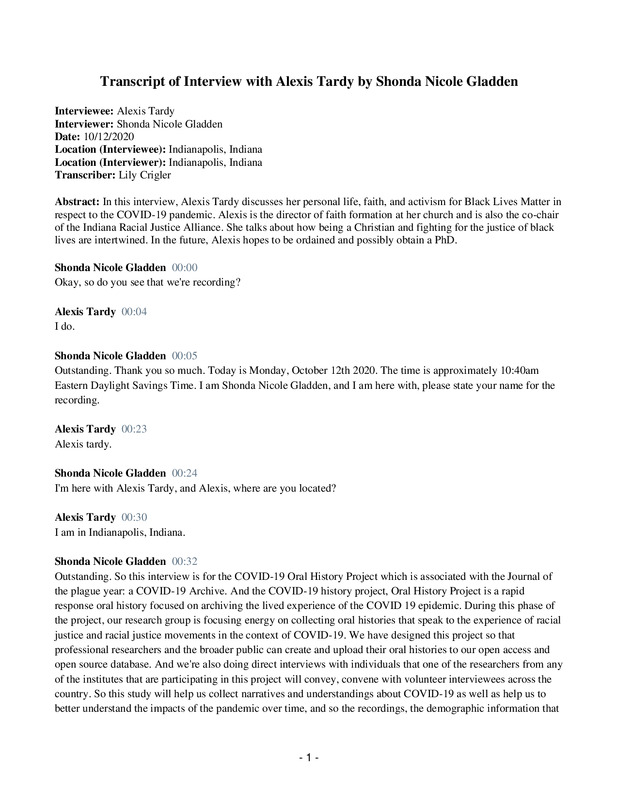 10/12/2020
10/12/2020Alexis Tardy Oral History, 2020/10/12
-
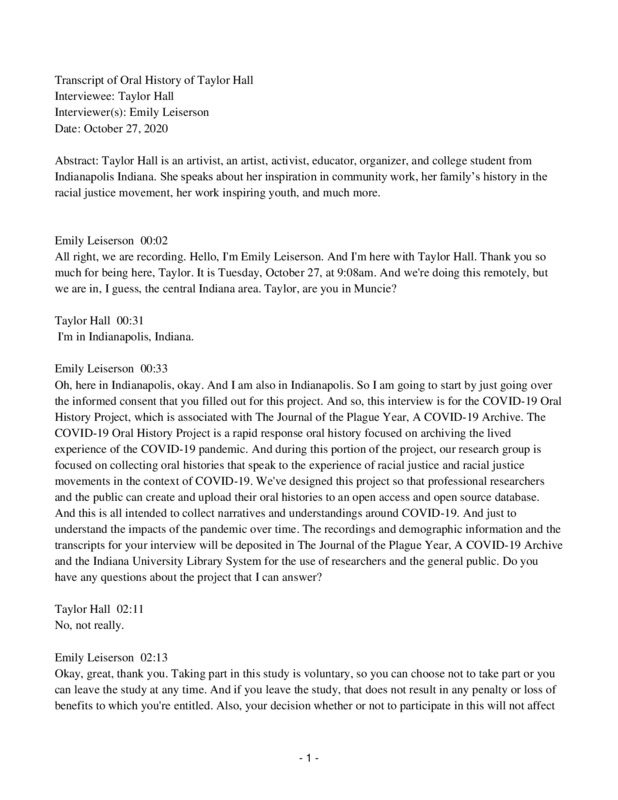 10/27/2020
10/27/2020Taylor Hall Oral History, 2020/10/17
C19OH -
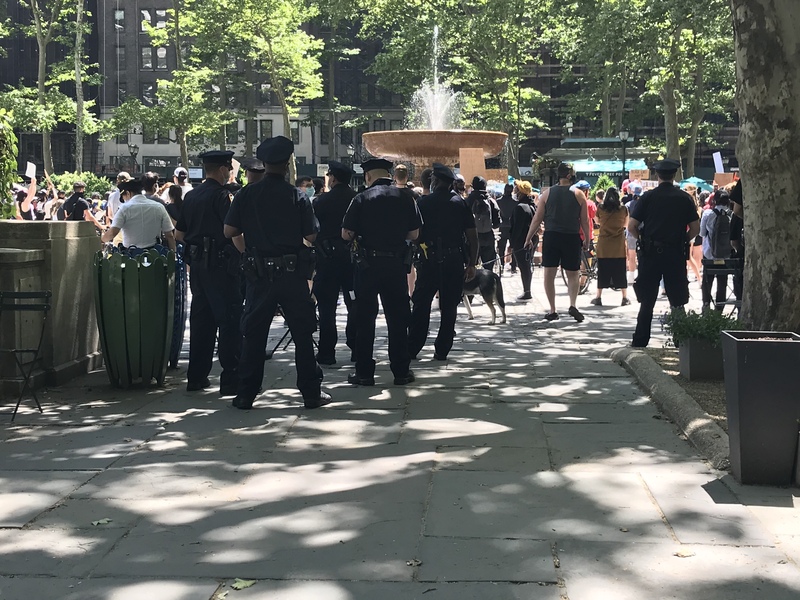 2020-05
2020-05Images from George Floyd Protests and BLM Demonstrations in New York City
Images taken of signs held while listening to speeches from BLM activists. Another image shows a cluster of police during a demonstration in Midtown Manhattan. -
 2020-05-31
2020-05-31I Can't Breathe
We marched up 4 miles of downtown Greenville chanting his name throughout the streets. I remember feeling like his name was a battle cry. I call to action. And a call for us to rise up and understand the true meaning of reason of why we choose to gather here today. George Floyd. His life was was tragically taken but his legacy was lovingly memorialize. It was beautiful to see and take part of historical moment like that. A moment of where a marginalized individual was taken out of the gaps and silences of history and placed right front and center within our cultural and society. -
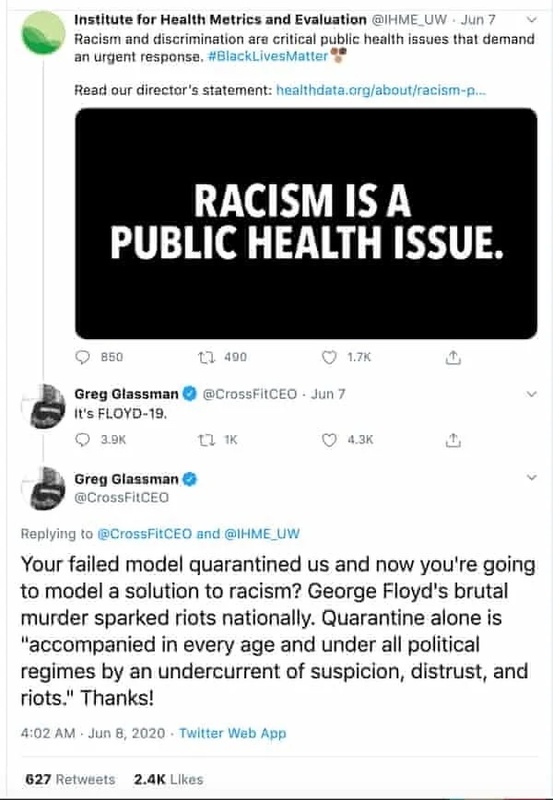 2020-06-08
2020-06-08Racism like Public Health?
Amidst Covid-19, the documentation of the police killings have been manifested into comparisons with the world-wide pandemic. These comparisons reflect the ongoing disparities between Black Americans and systemic racism. The Institute for Health Metrics and Evaluation takes to Twitter to try to support this comparison but faces a backlash from a fellow BLM support who argues that the comparison is invalid based on the different progress the BLM protest and quarantine had made. I felt like this was important for me to post because I feel like it shows an effort from BLM supporters to combat the racism within our culture by arguing that society must view and address racism as a public health issue. Yet, the tweet continues to evolve as ironic as the lack of regards Americans have for coronavirus policies and laws continues to grow everyday. Base on how events go, we might regard the validity of this statement to be false down the road. -
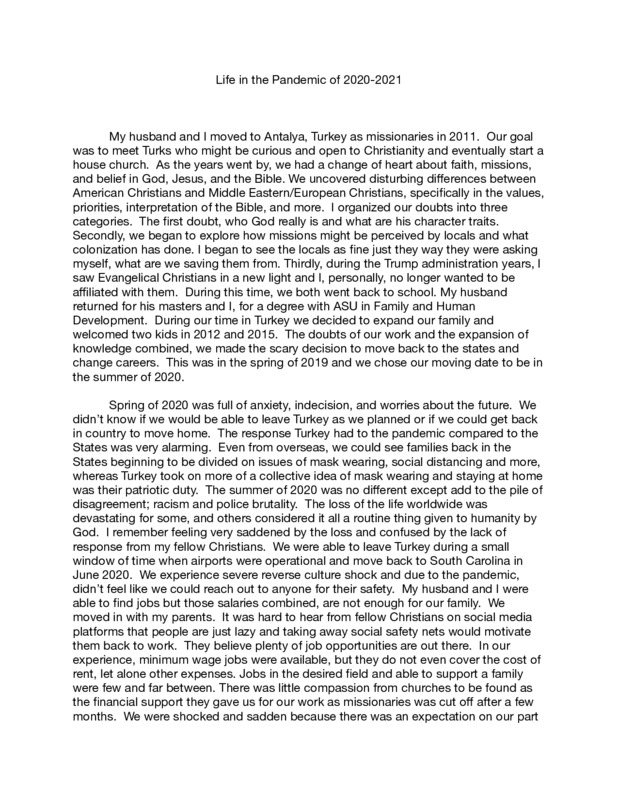 2021-10-06
2021-10-06Moving from Turkey to the United States During a Pandemic
This story describes moving a family from Antalya, Turkey to the United States during the pandemic of 2020/2021. It attempts to enlighten the reader to the types of issues people are dealing with and how it can change a person and reveal who people are. -
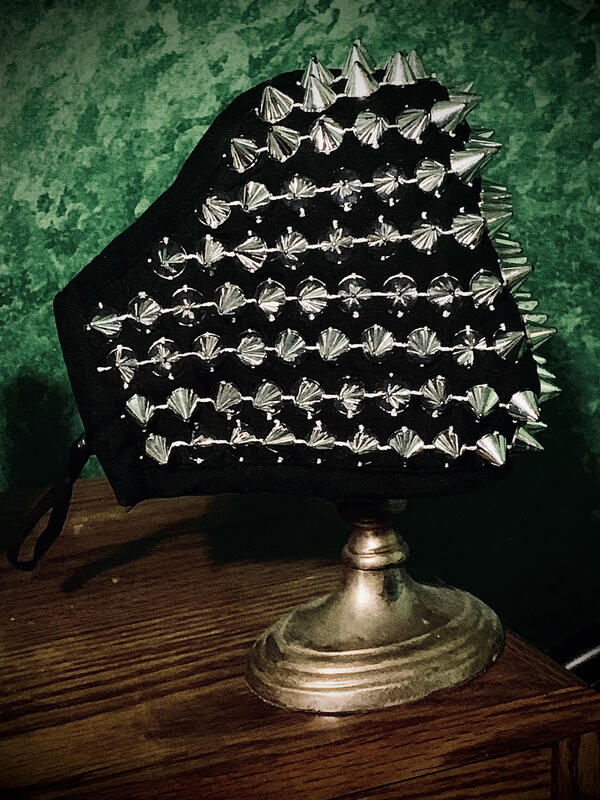 2021-10-03
2021-10-03A Century Later
A look at a global pandemic from a 21st century American point of view, nearly a decade after the last pandemic of the world. -
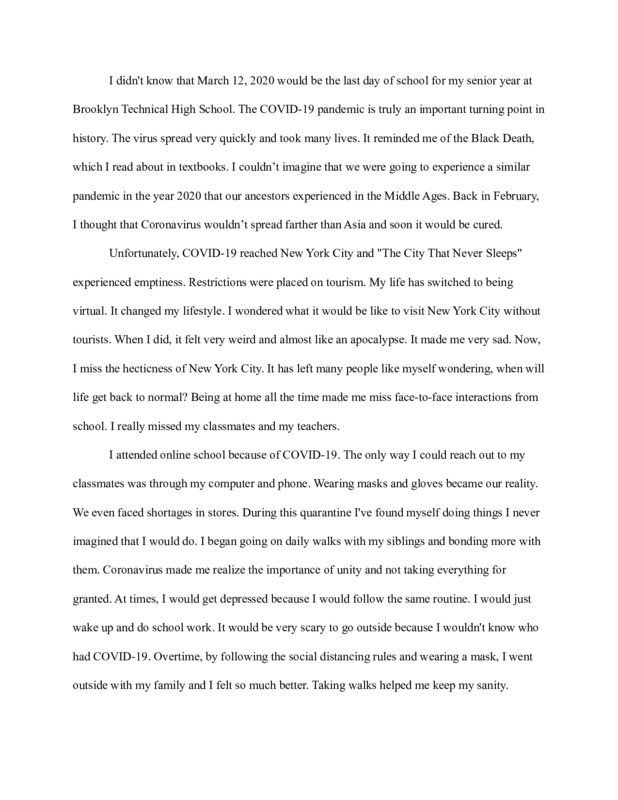 2020-03-12
2020-03-12Living post March 12, 2020
I want to share my feelings and thoughts through text that display what I experienced as a senior in high school during the outbreak of COVID-19. -
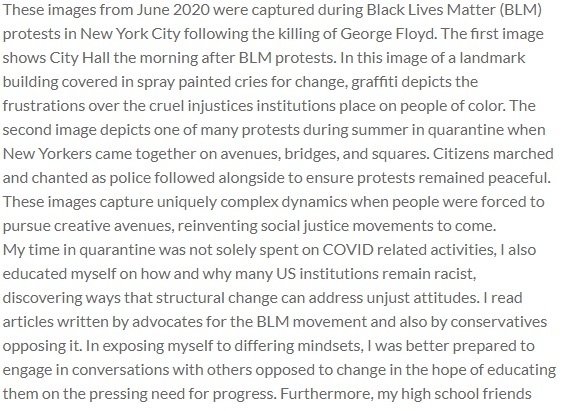 2020-06
2020-06Pandemic Protests
These images from June 2020 were captured during Black Lives Matter (BLM) protests in New York City following the killing of George Floyd. The first image shows City Hall the morning after BLM protests. In this image of a landmark building covered in spray painted cries for change, graffiti depicts the frustrations over the cruel injustices institutions place on people of color. The second image depicts one of many protests during summer in quarantine when New Yorkers came together on avenues, bridges, and squares. Citizens marched and chanted as police followed alongside to ensure protests remained peaceful. These images capture uniquely complex dynamics when people were forced to pursue creative avenues, reinventing social justice movements to come. My time in quarantine was not solely spent on COVID related activities, I also educated myself on how and why many US institutions remain racist, discovering ways that structural change can address unjust attitudes. I read articles written by advocates for the BLM movement and also by conservatives opposing it. In exposing myself to differing mindsets, I was better prepared to engage in conversations with others opposed to change in the hope of educating them on the pressing need for progress. Furthermore, my high school friends and I frequently Zoomed to discuss how our alma mater contributes to racism in both subtle and overt ways. These conversations allowed us to work with fellow alumni, as well as current students, to create a document clearly listing racial inequities within the student body, the faculty, and the curriculum. For each issue that we highlighted, we provided multiple alternatives for how the school could fix the matter in question. While these conversations were unexpected before the BLM protests occurred, they became productive and fulfilling conversations that in and of themselves began to address long held biases, racist representations and undercurrents of injustice within our alma mater’s community and programs. -
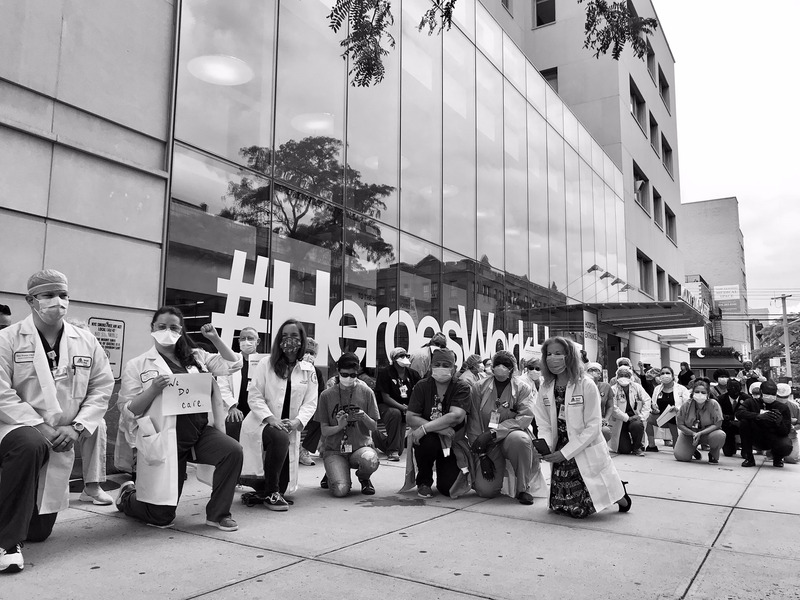 2020-05-02
2020-05-02On A Knee
The photo highlights a peaceful protest that involved the participation of medical faculty. The health care workers included in this photograph included doctors, nurses, admin, security guards and handful of maintenance. This was demonstration to support the Black Lives Matter Movement after the killing of a George Floyd at the hands of a police officer. The individuals in this photo can all be seen taking a knee similar to the protest method used by Colin Kaepernick. National Football League, player Colin Kaepernick took his first knee on September 1, 2016. The taking of the knee went against the tradition of standing during the signing of the National Anthem. Kaepernick said at the time: “I am not going up to show pride in a flag for a country that oppresses black people and people of color”. The people in this picture felt the same exact sentiments as Kaepernick. I chose this source because I wanted historians to understand the impact of the pandemic and the unity it created amongst individuals of different races. As a health care worker, I faced the challenges of Covid-19 directly. The fear of transmitting COVID-19 led to months of isolation from my loved ones. This feeling of loneliness contributed to the decline of mental health for me and many of my co-workers. On May 25, 2021, when George was murdered by a Minneapolis police officer over a suspicion of a counterfeit $20 bill my feeling of loneliness grew tremendously. Being an African American man in the united states was now just as dangerous as the virus killing thousands in New York. When the members of my staff came up the idea of protesting for the rights of African Americans, my feeling of loneliness begin to fade. Kneeling on the ground next to coworkers of all different races reminded of the inclusiveness and unity that we all needed in life. This was a moment in a history that will never be forgotten. -
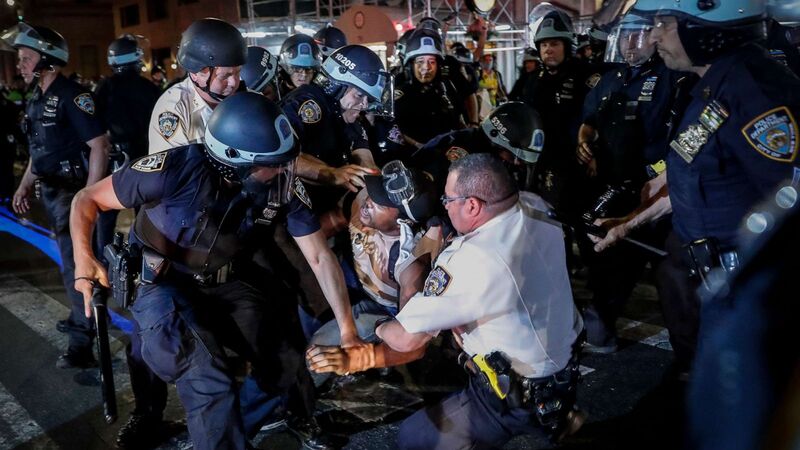 2021-05-18
2021-05-18BLM movement during COVID
The horrific and inhumane death of George Floyd was the absolute last straw for many people. His death caused such an uprising that no one was prepared for. Floyd’s death caused thousands of people across the country to protest and literally fight for their lives. Citizens began a peaceful protest which turned into violent protests which resulted in the burning and looting of the city of Minneapolis. This protest turned violent because even after the negative image the police had in the country’s eyes, they still proceeded to injure Americans, using rubber bullets and tear gas during these protests. I chose this picture because it is very impactful to me as a Black man in America it is terrifying and sad. The way police treat Black men such as myself is beyond scary and traumatizing. There are no words to describe how it feels to walk around as a man with brown skin. In the photo I selected, there are two police officers beating on a Black man while he is down on the ground. It baffles my mind how even after an individual is down, disarmed, and disables, police officers will continue to apply unnecessary force to the individual. The death of George Floyd and the events that took place after is a monumental event in history. People need to know how America, came together despite race and differences and protested to enforce the Black Lives Matter Movement. So many different groups of people put their differences aside and came together to protest the safety of Black people. It is important that police violence is captured not only for the justice of the individual who was hurt, but as a part of history. The police brutality and Black Lives Matter movement is very important part of history. This is a movement that brought together many individuals of different race, class, and beliefs to support the end the abuse of Black citizens of America. I chose this picture which occurred in Buffalo NY, officer decided to beat down a 75 year old man who was peacefully protesting. The idea of police who are supposed to serve and protect are beating an elderly man, imagine what they would do to a young man as myself. I’m glad these cruel acts of violence are now being captured and people are receiving the justice they deserve. It is also important for people to see these events as a part of history. -
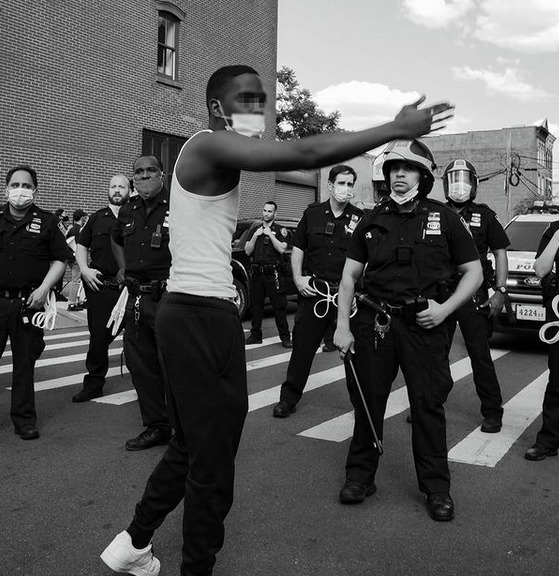 2020-05-30
2020-05-30Civil Discourse During A Pandemic
I assume like many New Yorkers, March 13th through 18th was when things really changed. It did for me on the 15th of March 2020 or the ides of March as I like to remember it. My store shut down for what seemed like 2 weeks. Of course, soon I would be given the news we would be shut down completely. I already knew where things were going, at the time I worked at an Asian restaurant, so I was hearing many of the conversations about China then. But I could not have predicted what would happen next. As slow and dreadful as 2020 was, things were moving at lightning speed for the situation we experienced. It felt like every few days something new would arise and test our nation. I selected these pictures because it shows how tired everyone is, the blank faces of people who are following orders, while the other side expresses their hardships all the while wearing masks, the bane of 2020. I want the historian of the future to know that no matter the situation at hand, many of us will still protest for what was wrong even if they got sick. It didn’t matter because we needed to send a message. The two images that you see in the beginning were taken by my friend, Emilio Lopez, who documented the protests, riots, and clashes between police in the summer of 2020. I did not go to the early protests because of covid and the violence/looting wasn’t the things I wanted to be a part of. I remember face-timing my friend to make sure if he was alright as I did not go with him. What he described to me that was happening in the parts of Fordham, and Union Square areas. Emilio had said many of the protesters were young men who were bored of the lockdowns and needed to do something exciting. There were fires, baton exchanges with the cops, and then the looting started. It all got a little too ugly for the whole week of George Floyd protests in New York. One of my close friend’s stores in Fordham was destroyed as a result. The images were taken right before things took a violent turn at Union Square. Where many of my friends were tear-gassed and beaten by cops to disperse when the first lockdown was getting implemented. Those two images, I feel like the body language of the subjects conveys how I felt about the lockdowns, the social injustice, in general about 2020. These were the first few weeks of protests that took place in the wake of George Fyold murder. I was shocked and scared when the masses went on to the streets because of the sheer amount while the pandemic was still going on. I hope the historians of the future can understand us even if they have to go through a cluster of memes from this era, real pictures with real human emotions will always speak louder I believe, and that civil rights in this country still have ways to go. -
 2020-03-13
2020-03-13The stolen year #REL101
When covid-19 first arrived, I was a senior in high school getting ready to graduate. At the moment, I'm writing this; I am currently in college, finishing my freshman year. When I first heard about covid 19, i did not think it was going to affect me because, at the time, the government was telling us that it wasn't a big deal. But that later turned out to not be true when everything shut down on March 13th. Even after the virus proved to be much deadlier than previously thought the most of the government still pushed that covid 19 was not a risk or that it would just simply go away. At the time, I can remember being confused because people were clearly dying. Yet, the government was urging people to act like everything was normal. After that day, the world changed forever. Nothing was the same, not even school. After March 13th, my high school went entirely virtual, with the plan being to come back after two weeks. Still, eventually, those plans like prom or even a regular graduation were canceled. I remember this time of my life being kind of hard because everything was shut down, and the world seemed to fall into chaos. Around may is when I would say things reached the height of the chaos of 2020. In May of 2020, George Floyd died when it seemed like the world went up in smoke. There were protests and riots, a lot of which I think stemmed from both the death of George Floyd and tension resulting from decades of racial tensions. As a black person myself, at this time, I felt anger but seeing as though there was still a virus and violence on the streets, I did not go to any of the protests. -
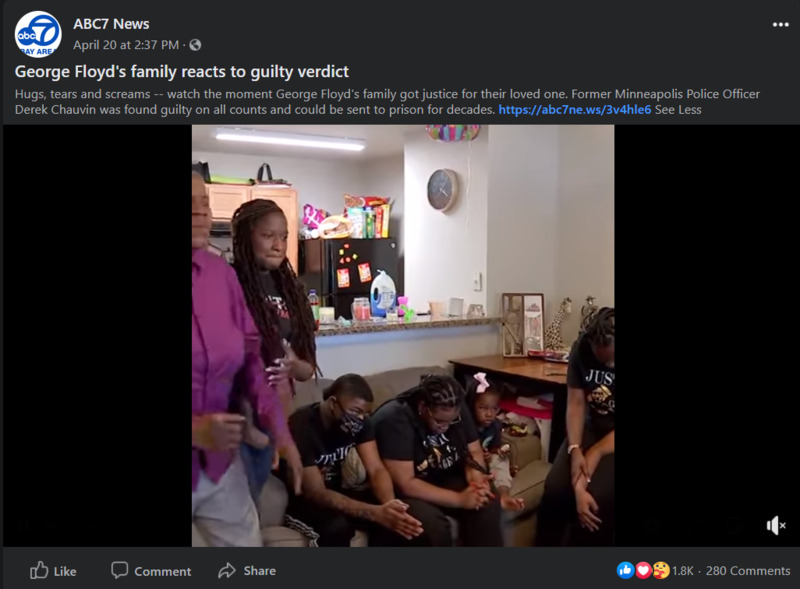 2021-04-20
2021-04-20George Floyd's family reacts to guilty verdict
Hugs, tears and screams -- watch the moment George Floyd's family got justice for their loved one. Former Minneapolis Police Officer Derek Chauvin was found guilty on all counts and could be sent to prison for decades. -
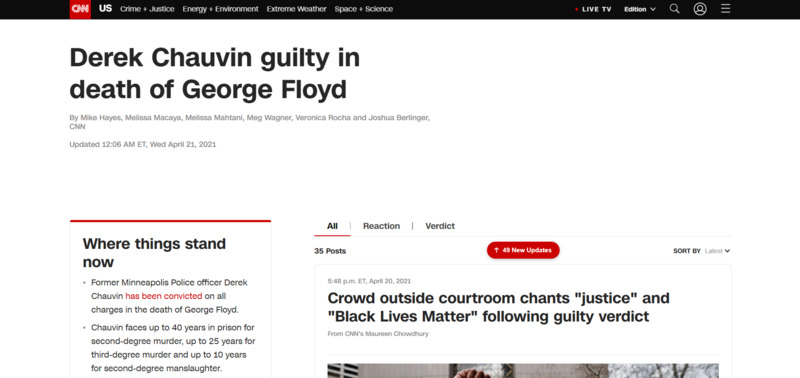 2021-04-21
2021-04-21Derek Chauvin guilty in death of George Floyd
The jury found former Minneapolis police officer Derek Chauvin guilty of all three charges in the murder of George Floyd. Crowds outside the Minneapolis courtroom and at the location where Floyd was killed chanted "justice" and "Black lives matter" after hearing the verdict. -
 2020-06-27
2020-06-27Dialogue on Race
For my contribution, I would like to highlight one of the most publicized events that occurred during the first few months of COVID-19, the George Floyd killing and my actions to bring unity after. This incident put a spotlight on social issues that have been long swept under the rug, racism, racial violence and police brutality. During this time, members of the Air Force spoke out and initiated conversations about race, and racial disparities within our ranks. -
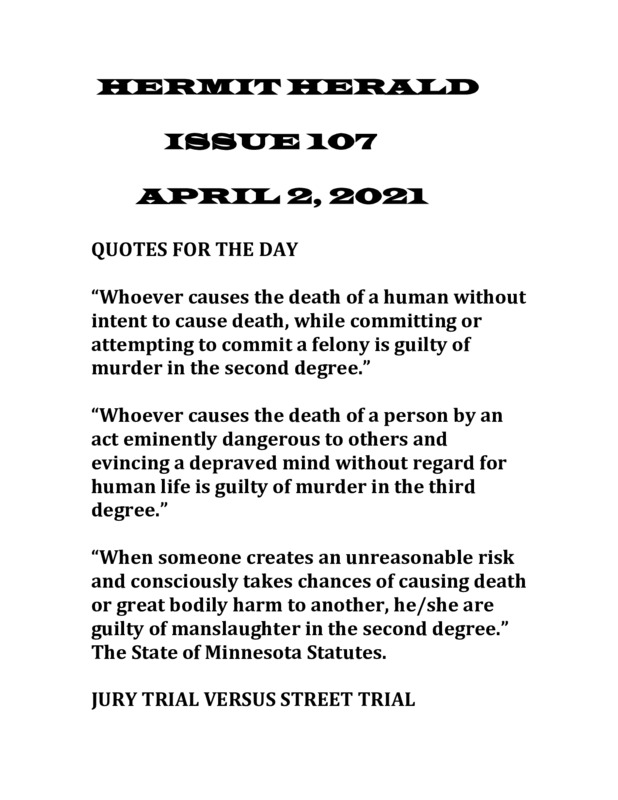 2021-04-02
2021-04-02hermit HERALD, ISSUE 107
George Floyd trial -
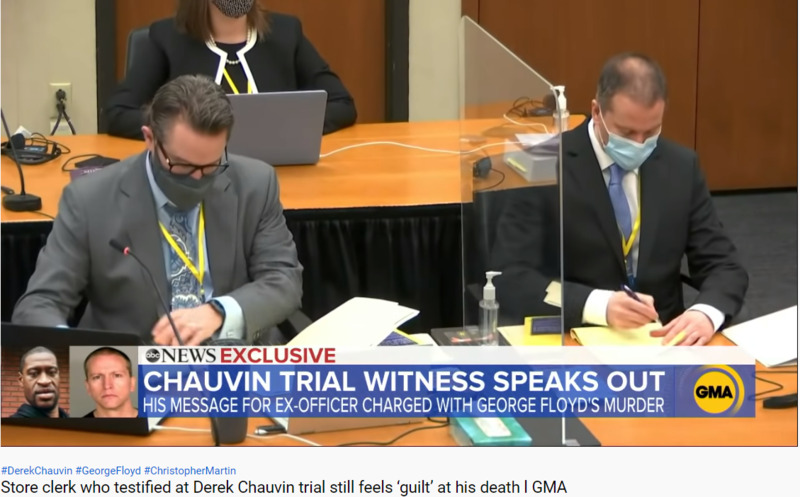 2021-04-02
2021-04-02Christopher Martin Testifies at Trial
Christopher Martin, 19, who reported George Floyd’s counterfeit $20 bill to his manager, said he feels like a “contributing factor” in his death. -
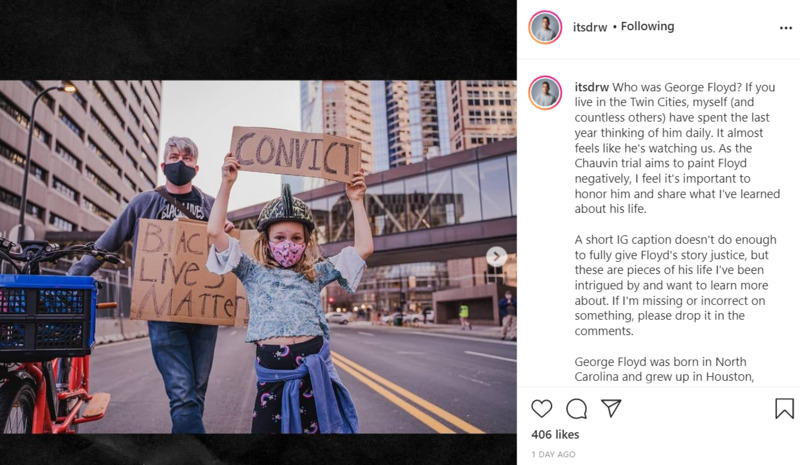 2021-04-02
2021-04-02Who was George Floyd?
Who was George Floyd? If you live in the Twin Cities, myself (and countless others) have spent the last year thinking of him daily. It almost feels like he's watching us. As the Chauvin trial aims to paint Floyd negatively, I feel it's important to honor him and share what I've learned about his life. A short IG caption doesn't do enough to fully give Floyd's story justice, but these are pieces of his life I've been intrigued by and want to learn more about. If I'm missing or incorrect on something, please drop it in the comments. George Floyd was born in North Carolina and grew up in Houston, Texas' Third Ward, a predominantly Black neighborhood in the city. His mother, a single parent, moved the family to the Third Ward when he was 2, so she could find work. At 6 feet, 6 inches, Floyd developed as a star tight end for Jack Yates High School and played in the 1992 state championship game in the Houston Astrodome. With dreams of turning pro, he attended South Florida State College on a partial scholarship. After two years there, Floyd spent a year at Texas A&M University before returning to Houston and his mother’s apartment to find jobs in construction and security. While there, he ended up bouncing between jobs before serving nearly five years in prison. Floyd was also a musician, he occasionally was invited to rap with DJ Screw, a producer whose music is recognized as cementing Houston as a stronghold for hip-hop. He performed as a rapper using the stage name Big Floyd in a hip hop group, Screwed Up Click. As a father looking to provide for his five children and find a fresh start, Floyd moved to Minneapolis. One of his first jobs was working as a security guard at the Salvation Army’s Harbor Light Center -- the city’s largest homeless shelter. Floyd kept his connection to Houston, regularly returning to the Third Ward before his death. ✊🏽❤️ -
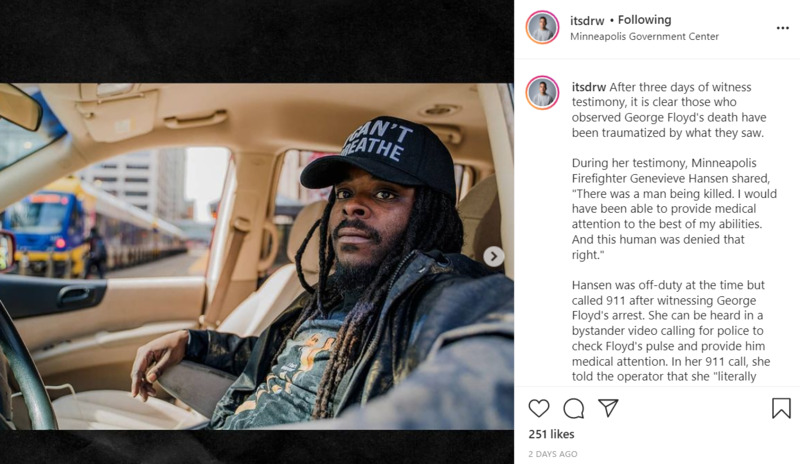 2021-04-01
2021-04-01After three days of witness testimony, it is clear those who observed George Floyd's death have been traumatized by what they saw.
After three days of witness testimony, it is clear those who observed George Floyd's death have been traumatized by what they saw. During her testimony, Minneapolis Firefighter Genevieve Hansen shared, "There was a man being killed. I would have been able to provide medical attention to the best of my abilities. And this human was denied that right." Hansen was off-duty at the time but called 911 after witnessing George Floyd's arrest. She can be heard in a bystander video calling for police to check Floyd's pulse and provide him medical attention. In her 911 call, she told the operator that she "literally watched police officers not take a pulse and not do anything to save a man." Photos taken at the All Eyez On Justice Rally, March 28, 2021. -
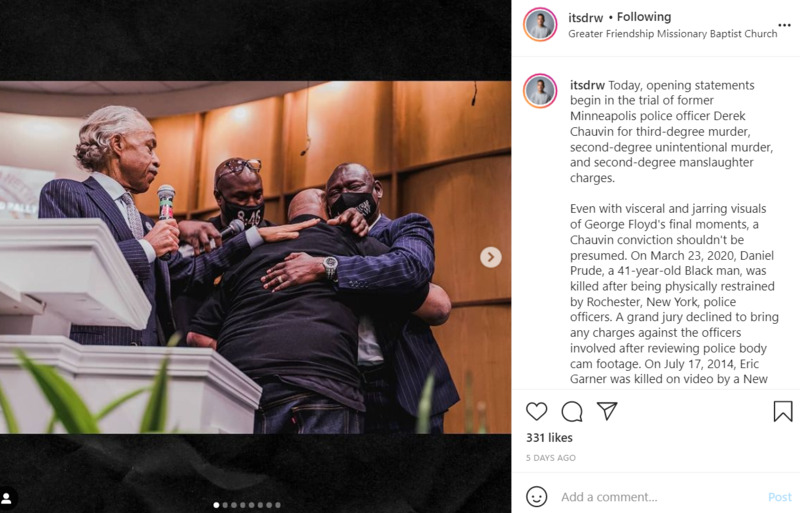 2021-03-29
2021-03-29Today, Opening Statements Begin in the trial of Derek Chauvin
Today, opening statements begin in the trial of former Minneapolis police officer Derek Chauvin for third-degree murder, second-degree unintentional murder, and second-degree manslaughter charges. Even with visceral and jarring visuals of George Floyd's final moments, a Chauvin conviction shouldn't be presumed. On March 23, 2020, Daniel Prude, a 41-year-old Black man, was killed after being physically restrained by Rochester, New York, police officers. A grand jury declined to bring any charges against the officers involved after reviewing police body cam footage. On July 17, 2014, Eric Garner was killed on video by a New York City police officer who put him in a prohibited chokehold while arresting him. After a grand jury considered the case for two months, they decided not to indict the officer involved. Last night, Rev. Al Sharpton, Attorney Benjamin Crump, and the family of George Floyd held a vigil to honor George Floyd before the trial began. -
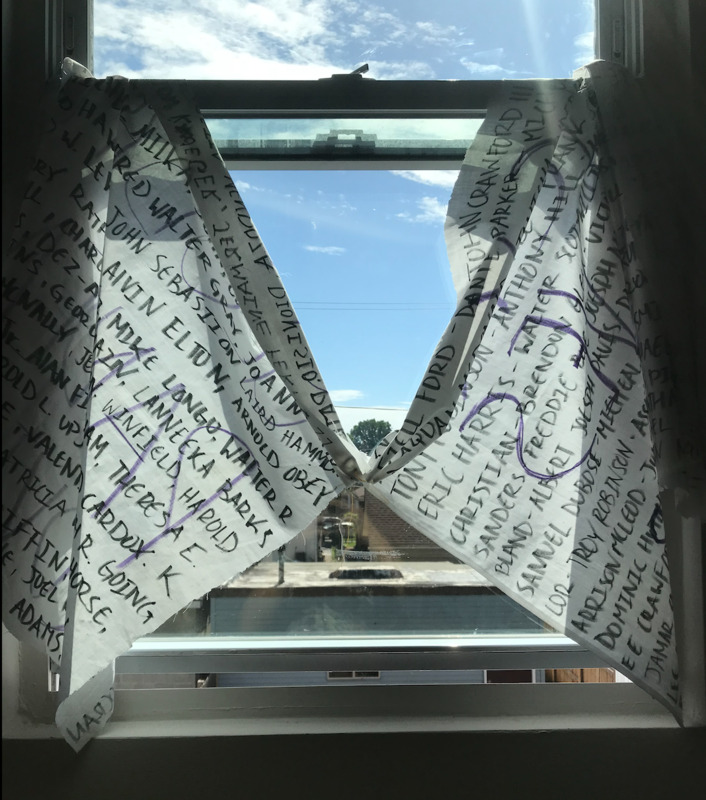 2020-06-09
2020-06-09Pandemic
As of today, we as a society have been struck by two major pandemics, COVID-19 and Racism. Although both of these pandemics aren't an easy fix it is important to acknowledge and remember those that have lost there lives to these two catastrophes. On each of the two sheets, I wrote down the names of 100 people that have lost to either the virus or police brutality in the United States on the backside of each sheet I wrote 'Black Lives Matter' and 'Covid-19' to signify the cause of death for the said group of names. I decided to sew the two sheets together to show how in both instances racial discrimination and bias can be accounted for as reasons for the death of these individuals. For this project, I wanted to make a piece to remember the people behind the statistics, to humanize them in an otherwise forgetful world, and to say their names. -
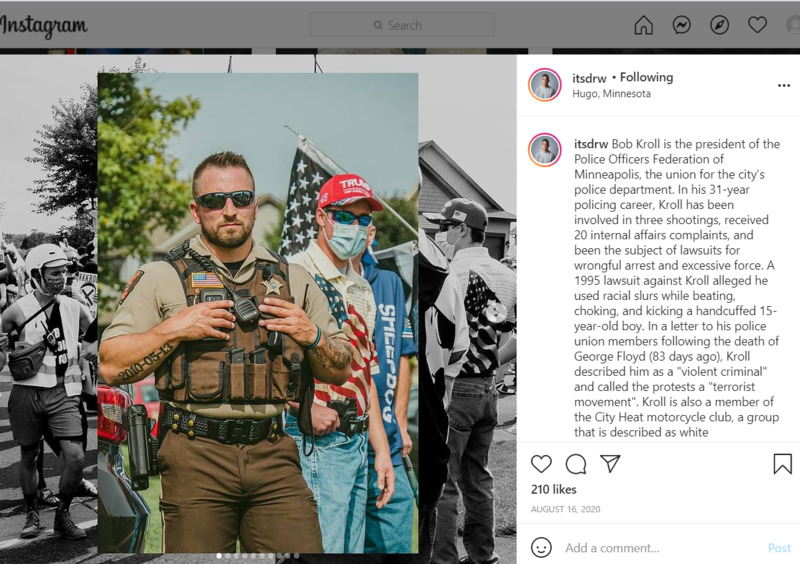 2020
2020Protest Against Bob Kroll Wrongful Arrest and Excessive Force
Bob Kroll is the president of the Police Officers Federation of Minneapolis, the union for the city's police department. In his 31-year policing career, Kroll has been involved in three shootings, received 20 internal affairs complaints, and been the subject of lawsuits for wrongful arrest and excessive force. A 1995 lawsuit against Kroll alleged he used racial slurs while beating, choking, and kicking a handcuffed 15-year-old boy. In a letter to his police union members following the death of George Floyd (83 days ago), Kroll described him as a "violent criminal" and called the protests a "terrorist movement". Kroll is also a member of the City Heat motorcycle club, a group that is described as white supremacists by the Anti-Defamation League. Yesterday, protesters gathered outside Kroll's home in Hugo, MN and marched in his neighborhood demanding his resignation. Photos from Let’s Roll to KKKroll’s!, Aug 15, 2020 -
 2020-08-29
2020-08-29March on Washington 57th Anniversary
On the 57th anniversary of the March on Washington, tens of thousands of people gathered to demand racial equality and an end to police brutality in the US. The rally was organized by Al Sharpton’s National Action Network, the NAACP and the National Urban League. The families of George Floyd, Trayvon Martin, Eric Garner, Ahmaud Arbery, Breonna Taylor, and Jacob Blake, shared stories and called for systemic change. Organizers reminded attendees to practice social distancing and wear masks throughout the program. 1. Rev Al Sharpton speaking with an attendee 2. George Clinton cooling off before his performance 3. Black Panther Party member overlooking the crowd 4. Young boy holding Black Lives Matter poster 5. Martin Luther King III giving advice to activist from Texas 6. View of the crowd from the Lincoln Memorial steps -
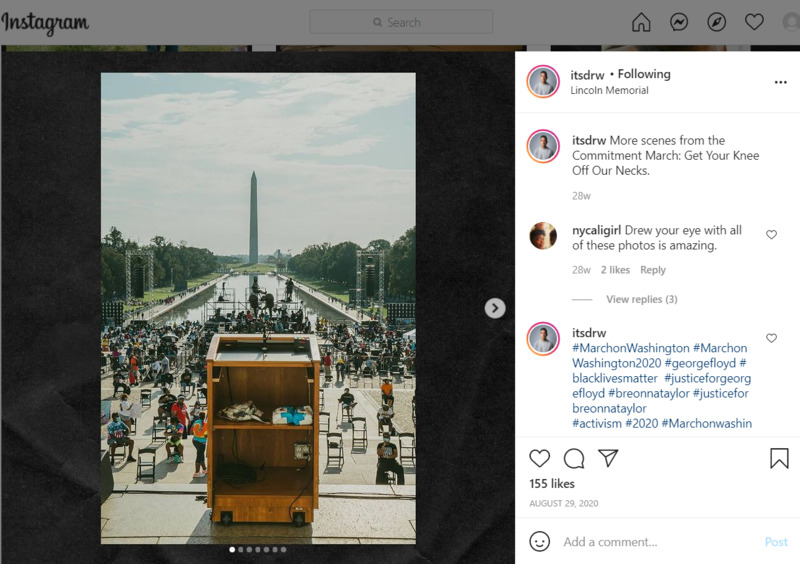 2020-08-29
2020-08-29Get Your Knee Off Our Necks
More scenes from the Commitment March: Get Your Knee Off Our Necks. -
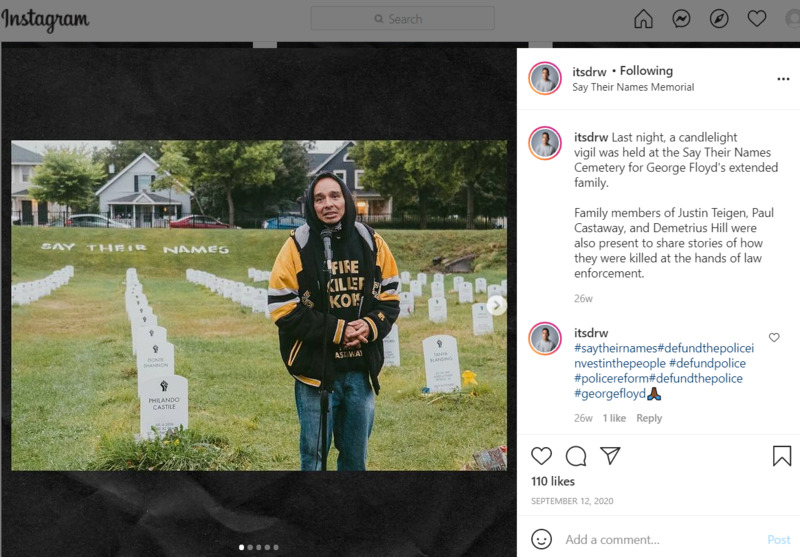 2020-09-12
2020-09-12Candlelight Vigil Held at the Say Their Names Cemetery for George Floyd's Extended Family
Last night, a candlelight vigil was held at the Say Their Names Cemetery for George Floyd's extended family. Family members of Justin Teigen, Paul Castaway, and Demetrius Hill were also present to share stories of how they were killed at the hands of law enforcement. -
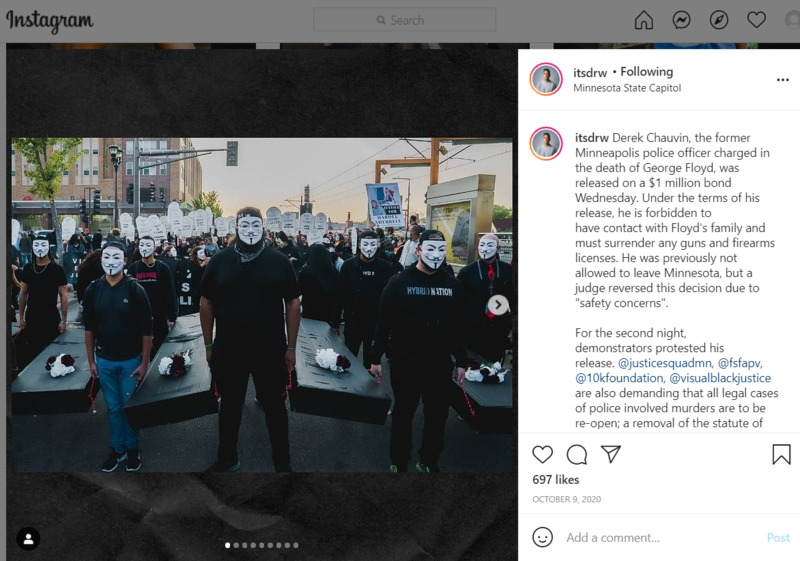 2020-10-09
2020-10-09Derek Chauvin released on a $1 Million Bond
Derek Chauvin, the former Minneapolis police officer charged in the death of George Floyd, was released on a $1 million bond Wednesday. Under the terms of his release, he is forbidden to have contact with Floyd's family and must surrender any guns and firearms licenses. He was previously not allowed to leave Minnesota, but a judge reversed this decision due to "safety concerns". For the second night, demonstrators protested his release. @justicesquadmn, @fsfapv, @10kfoundation, @visualblackjustice are also demanding that all legal cases of police involved murders are to be re-open; a removal of the statute of limitations on these cases, and an end to qualified immunity for police officers. -
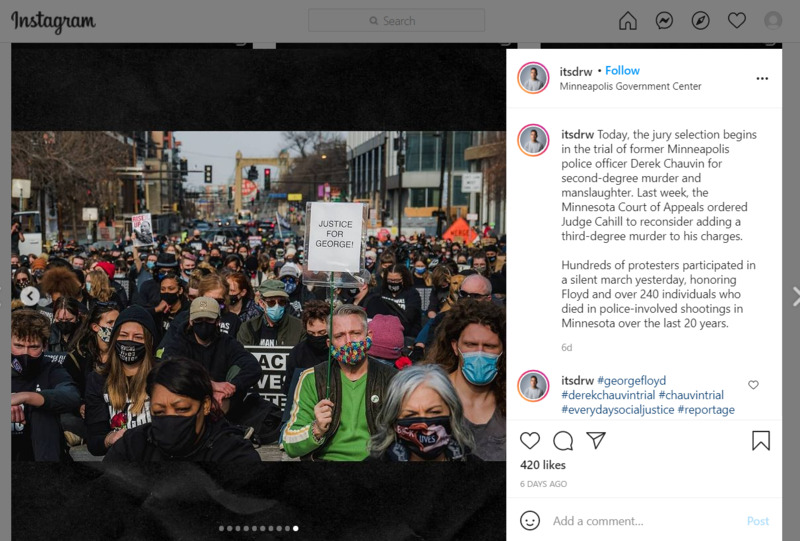 2020-03-08
2020-03-08Jury Selection for Derek Chauvin Silent March
From Drew Arrieta: Today, the jury selection begins in the trial of former Minneapolis police officer Derek Chauvin for second-degree murder and manslaughter. Last week, the Minnesota Court of Appeals ordered Judge Cahill to reconsider adding a third-degree murder to his charges. Hundreds of protesters participated in a silent march yesterday, honoring Floyd and over 240 individuals who died in police-involved shootings in Minnesota over the last 20 years. -
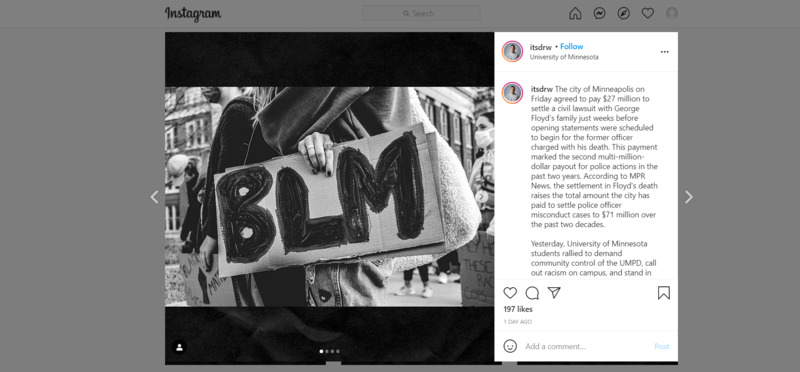 2021-03-13
2021-03-13University of Minnesota students rallied to demand community control of the UMPD
From the Instagram post: The city of Minneapolis on Friday agreed to pay $27 million to settle a civil lawsuit with George Floyd's family just weeks before opening statements were scheduled to begin for the former officer charged with his death. This payment marked the second multi-million-dollar payout for police actions in the past two years. According to MPR News, the settlement in Floyd’s death raises the total amount the city has paid to settle police officer misconduct cases to $71 million over the past two decades. Yesterday, University of Minnesota students rallied to demand community control of the UMPD, call out racism on campus, and stand in solidarity with the family of George Floyd. -
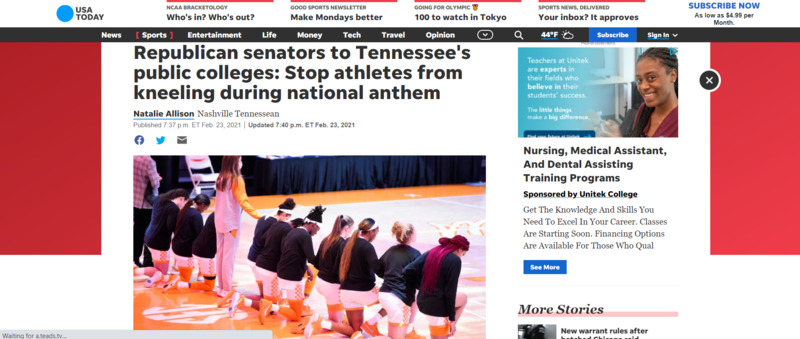 2021-02-23
2021-02-23Republican senators to Tennessee's public colleges: Stop athletes from kneeling during national anthem
In a virtual interview, Rennia Davis explains why the Lady Vols knelt during the national anthem. From the article: Tennessee Republicans are up in arms over a state college basketball team's decision to kneel last week during the playing of "The Star-Spangled Banner," prompting legislators to warn the public university system not to allow student athletes to do so again. -
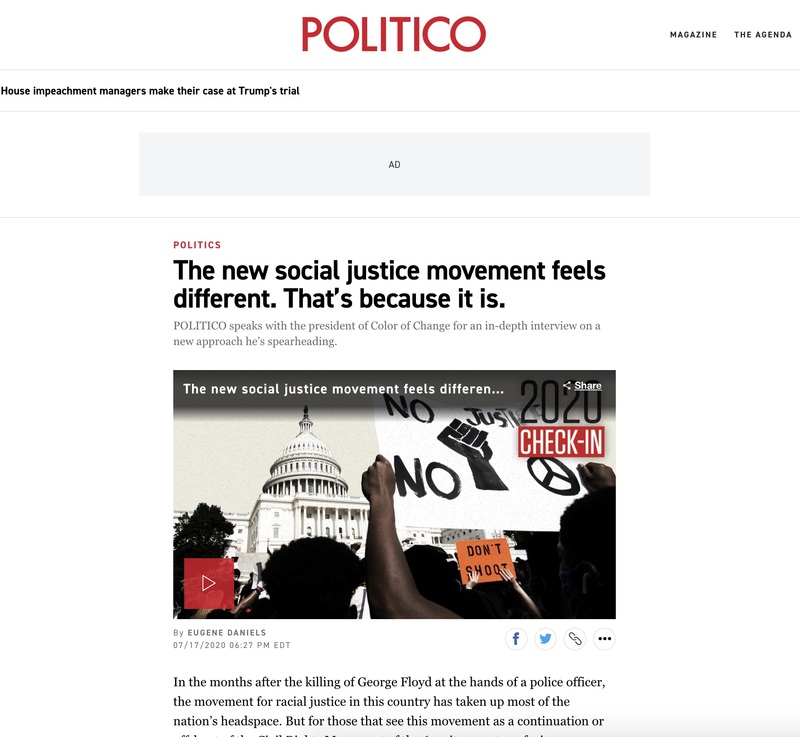 2020-07-17
2020-07-17The new social justice movement feels different. That’s because it is.
Politico looks at the social justice movements today in comparison to the Civil Rights Movements of the 1960's. For one, there are no clear leaders of the modern day social justice movements and there is less of a desire for political collaboration on issues today. The video shows movements present and why this movement is different than those of the past. -
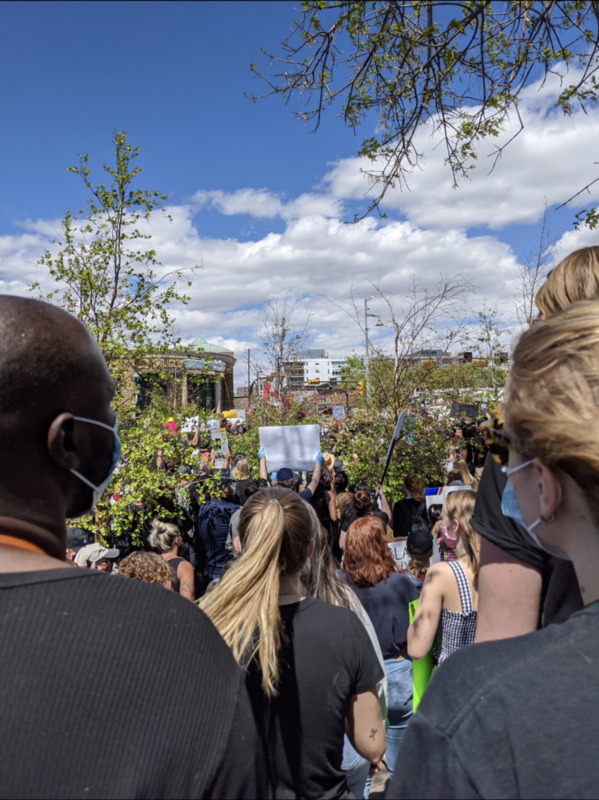 2020-06-03
2020-06-03Black Lives Matter Rally in Calgary Alberta
This is a photo I took during one of Calgary’s Black Lives Matter marches in the Summer of 2020. In the wake of the murder of George Floyd, people took to the streets all over the world, not just America – In Calgary Alberta in particular, the death of George Floyd forced Canadians to critically look at our own law enforcement and state institutions, which were borne out of Canada’s colonial past. Not pictured in this photo would be the flags of numerous Indigenous nations, in particular the Mohawk nation – as in Canada and in America, the Black Lives Matter Movement synthesized itself with the cause of Indigenous sovereignty, as a means to combat white supremacy. During these marches, people who were antagonistic of the BLM movement stated that these marches were a threat to ‘public health’ as they believed protestors were marching mask less, this is not the case as evident in this photo. Organizers and random protestors were handing out masks, hand sanitization stations were set up with food, water and wipes. Signs were provided from the organizers to each marcher, if one did not bring their own. During this event, there was limited police presence as they maintained their distance from the large body of protestors which covered several streets. From what I recall what happened, I went with my friend Quinn, we showed up and found a place in the large crowd and listened to several speakers in the center of body of protestors (You can’t see it in this photo but it is directly center, behind the foliage). After the several speeches which took place, the organizers lead the people through a march downtown, to city hall. To my knowledge, there weren’t any instances of violence or confrontations with police – however I do remember there would be some agitators who would appear every now and then to yell at the protestors, or carry racist signs – I didn’t see this in particular, but saw photos of people doing so. This photograph would be beneficial to the social justice collection as it depicts the black lives matter movement of Calgary Alberta, Canada as fore mostly a window into the unique Canadian experience and similarly to how protests were conducted during a pandemic.
